Overview
With a VMware Standard backup, you will be able to restore the virtual machine back to a specific point in time, either into production or into an isolated sandbox environment.
With VMware Standard restores, you can perform the following actions:
- Restore VMs locally or from the cloud
- Restore VMs in a sandboxed test mode or production mode
- Choose to start the VMs automatically upon restore or not
VMware Standard Recovery Types
While performing the restore procedure, you are prompted to select how to verify and recover your data to the restore destination. The following options are provided:
- Sandboxed Test Recovery
- Production Recovery
Sandboxed Test Recovery is a safe means for you to verify the integrity of your backed-up VMs without affecting normal business operation. Your production VMs remain powered on and operational. The selected recovery VMs are powered on within an isolated VLAN.
Production Recovery performs an instant recovery of your production VMs with selected recovery VMs. If the production VM is still running, it is shut down before powering up the recovery VMs.
Restoring VMware Standard Backup Sets
To restore a VMware Standard backup set, perform the following steps.
- Navigate to the Computer page. See Navigating to the Computer Page for instructions.
The Computer page is displayed.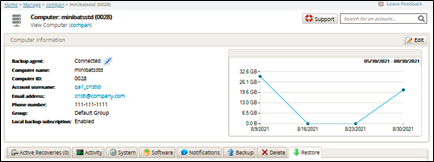
Click the Restore tab.
The Restore Selections page is displayed.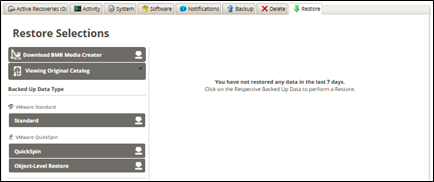
Click VMware Standard.
The Select page is displayed.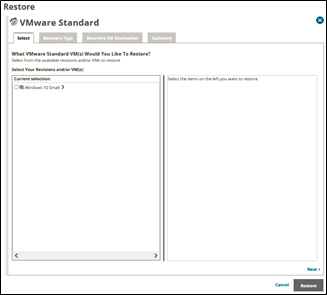
In the Current Selection pane, select the VMs and revisions to be restored.
Clicking the arrow at the right of the VM displays more revisions of the VM, as shown below.
at the right of the VM displays more revisions of the VM, as shown below.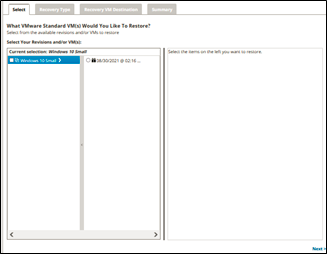
After selecting your revisions Your selection is displayed in the right pane.
Click the remove icon
 to remove any selections or clear the item check box.
to remove any selections or clear the item check box.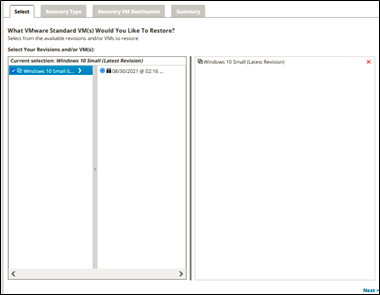
After making your selections, click Next.
The Recovery Type page is displayed.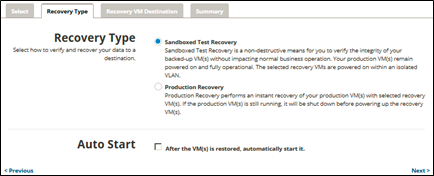
Select how to verify and recover your data to the restore destination.
If you select Sandboxed Test Recovery (default option):
The source/production VMs are not shut down.
The recovery VMs selected are started on their own separate VLAN to avoid Network IP conflicts with the production VMs.If you select Production Recovery:
The source/production VMs are shut down (if available and if possible).
The recovery VMs. once restored, are started on the production network. They assume the role of the original production VMs.
See VMware Standard Recovery Types for more information.Optionally, select the After the VM(s) is restored, automatically start it check box
Note: When enabled, Auto Start starts the VMs automatically upon restore.Click Next.
The Recovery VM Destination page is displayed.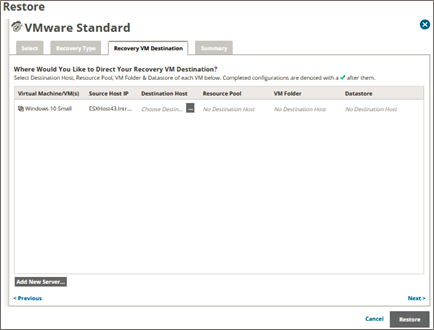
Requirements: You must select the Destination Host and the Datastore where you want to restore the recovery VMs. The Resource Pool and VM Folder are optional; however, you must select None if you do not want these options.
To add a new destination ESXi or vCenter server, see Adding a New ESXi or vCenter Server else proceed to next step.
Select the ellipsis
 in the Destination Host column.
in the Destination Host column.The Destination Host pop up is displayed.
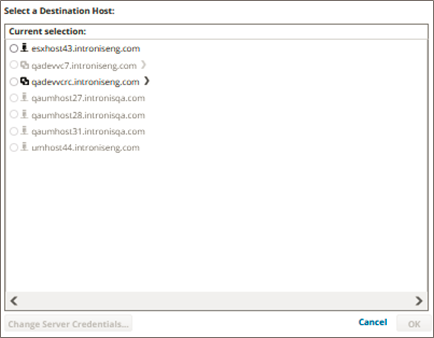
Select the Destination Host.
The Change Server Credentials option is activated.
To change server credentials, see Changing Server Credentials; else proceed to next step.
The ellipses are displayed for the other options.
Select the ellipsis
 in the Resource Pool column.
in the Resource Pool column.
The Resource Pool pop up is displayed.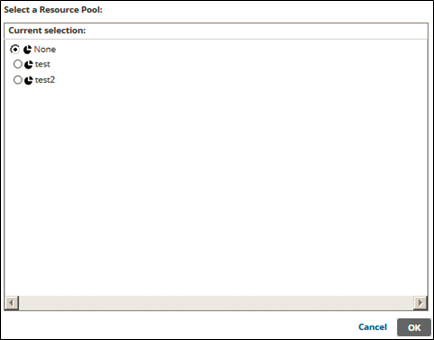
Select the Resource Pool radio button, and then click OK.
Select the ellipsis
 in the VM Folder column.
in the VM Folder column.
The VM Folder pop up is displayed.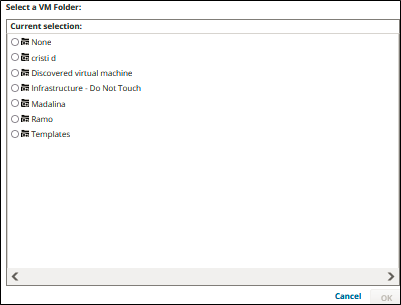
Select the VM Folder radio button or if you do not want a VM Folder, select the None radio button, and then click OK.
Select the ellipsis
 in the Datastore column.
in the Datastore column.
The Datastore pop up is displayed.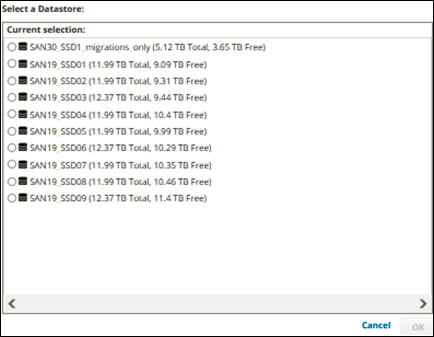
Select a Datastore radio button, and then click OK.
After making your selections, the completed configuration is denoted with a check mark as shown below.

Click Next.
The Summary page is displayed.
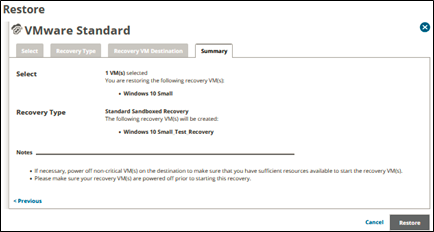
Verify your selections, and then click the Restore button.
If you selected Production Recovery at the Destination page, then the following confirmation pop-up is displayed.

By selecting the checkbox and selecting Yes, the currently running Production VM(s) are shut down and replaced by the VMware Standard VMs you have selected to restore.
Click the Yes, restore the selected VM(s) check box, and then click Yes.
If you selected Sandboxed Test Recovery at the Destination page, then the following confirmation pop-up is displayed.
Click Yes.
The Restore Selections page is displayed showing the status of the restore.
Note: If the destination host you restore to has a VM with the same name, the restored VM appends the following extension to the name:
_Recovery (or Recovery1 if _Recovery exists).
